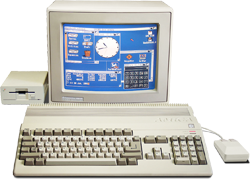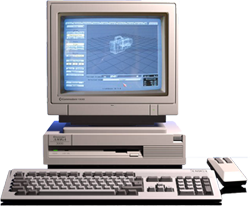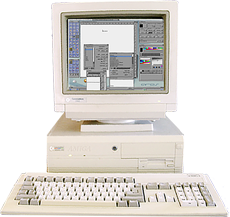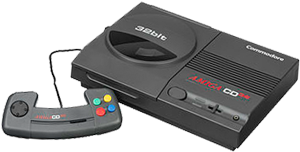"A2000 -The Hollywood Star"
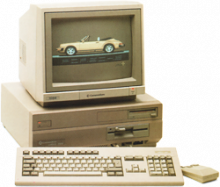
Released in March 1987, the Commodore Amiga 2000 (A2000) was a powerful and highly expandable computer designed for professionals. Based on the Motorola 68000 CPU, the A2000 featured OCS graphics, stereo PCM audio, multitasking, and a graphical user interface, making it ideal for creative, business, and technical applications.
The A2000 was discontinued in 1991, shortly after the launch of the Amiga 3000. With its open architecture and Zorro II bus, it became the platform of choice for organizations like NASA and television studios using the legendary Video Toaster video effects system.
-
Launch Price: $1,495 (equivalent to around $3,800 in 2023)
-
Widely adopted in TV production and digital art, thanks to its multimedia capabilities
![]() A2000 AT A GLANCE
A2000 AT A GLANCE
 CPU: Motorola 68000 @ 7.16 MHz (NTSC) / 7.09 MHz (PAL)
CPU: Motorola 68000 @ 7.16 MHz (NTSC) / 7.09 MHz (PAL)- OS: AmigaOS 1.3 (also supports 1.2 / 2.0)
- RAM: 1 MB total (512 KB chip RAM + 512 KB additional RAM)
- ROM: 256 KB / 512 KB Kickstart
- Graphics: OCS chipset, up to 4,096 colors on screen
- Sound: 4-channel 8-bit PCM stereo audio
- Expansion: 5 × Zorro II slots, 4 × ISA slots
- Fully compatible with the original Amiga 1000 and Amiga 500
 Colors & Graphic Modes
Colors & Graphic Modes
OCS graphics offered vibrant and flexible display capabilities:
- Color palette: 12-bit (4,096 colors)
- On-screen color modes:
- 32 colors (standard)
- 64 colors (EHB - Extra Half-Brite)
- 4,096 colors (HAM - Hold-And-Modify)
- Graphics could be upgraded to ECS or RTG via expansion cards.
PAL Modes: 320×256, 640×256, 640×512 (interlaced), up to 704×576 (overscan)
NTSC Modes: 320×200, 640×200, 640×400 (interlaced), up to 704×484 (overscan)
![]() Sound Capabilities
Sound Capabilities

Like all classic Amigas, the A2000 delivered impressive audio for its time:
- 4 × 8-bit PCM audio channels (2 stereo)
- Sampling rate: 28 kHz (standard), up to 57 kHz
- Independent volume control (65 levels)
- Low-pass audio filter (software-controllable)
- Expandable via audio cards for enhanced sound production
 I/O Ports
I/O Ports
- 2 DE-9 ports for mouse and joystick
- Keyboard port (5-pin DIN)
- Centronics style parallel port (DB-25F)
- RS-232C compatible serial port
- Analog RGB video out (DB-23M) compatible with old Amigas
- Mono video (RCA)
- Audio out (2 × RCA)
- 2nd disk drive (3.5" drive or 5.25" for IBM PC compatibility)
- Internal hard disk (requires a SCSI controller)
 Monitors
Monitors
- Commodore monitors (1084, etc.)
- Other RGB monitors (Philips CM 8833, etc.)
- 15 kHz VGA monitors with RGB to VGA adapter (monitors such as BenQ)
- TVs via SCART cable (RGB to SCART)
- Modern VGA/HDMI monitors via video upscaling hardware
 Related Models: A2000
Related Models: A2000
Amiga 2000/HD
-
Same as A2000 but bundled with a SCSI hard drive
Amiga 2500/20 (1988)
- 68020 CPU @ 14.3 MHz
- 2 MB 32-bit RAM, 68881 FPU, and 68851 MMU
Amiga 2500/30 (1989)
- 68030 CPU @ 25 MHz via A2630 accelerator card
- 4 MB RAM, expandable up to 64 MB, 68882 FPU
Amiga A2500UX
- A2500 system running Unix, bundled with a tape drive
- Based on the Amiga 2500/30 hardware
 A2000 Upgrades
A2000 Upgrades
The A2000 was one of the most expandable Amigas ever made, offering five (5) Zorro II card slots and four (4) PC ISA slots in the motherboard.
- The CPU can be directly upgraded to a 68010
- Accelerators (68020/68030/68040)
- Hard disk and CD-ROM drives
- ZIP drive (Iomega Zip Drive)
- Internal Gotek drive (2nd drive)
- Graphic cards (Picasso, ZZ9000, etc.)
- Audio cards (Prisma Megamix, ZZ9000AX for the ZZ9000, etc,)
- Network cards
- A2088 bridgeboard (IBM XT), and other cards for up to 80486 PC emulation
- The iconic Video Toaster from NewTek
Legacy -The Commodore Amiga 2000
With true multimedia power and extensive expansion options, the Amiga 2000 became a cornerstone for digital creators, engineers, and hobbyists alike. Whether in a NASA lab or a TV production studio, it stood out as one of the most versatile computers of its time.
■ The Amiga 2000
BinaryValue.com (c)














 TOP-10 APPS
TOP-10 APPS